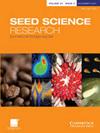Environmental predictors of seed germination in two Halocnemum species from Mediterranean (Balearic, Tyrrenic and Adriatic) and Red Sea coastal salt marshes
IF 1.9
3区 生物学
Q2 PLANT SCIENCES
引用次数: 0
Abstract
Abstract Reproductive strategies for specific populations are closely related to environmental factors. Consequently, they are fundamental for conservation plans and the management of threatened habitats like salt marshes. From this viewpoint, germination strategy under different temperatures and salt conditions, voltammetric parameters and molecular analysis were performed and compared in six Halocnemum populations (four of H. cruciatum and two of H. strobilaceum) growing on Mediterranean (Balearic, Tyrrenic and Adriatic) and Red Sea coasts to establish the relation to environmental variables. Significant interpopulation differences were found in all the evaluated parameters. The Mediterranean populations showed a variable opportunistic germination strategy that was directly related to the drought period length at the studied sites. Consequently, potential environmental predictors of seed response were identified. The most noteworthy were bioclimate, soil texture, continentality index, winter temperatures and summer precipitations. Additionally, voltammetric parameters were evidenced as indicators of maternal plant stress levels and, thus, as potential determinants of future seed responses. The phylogenetic analyses showed a split into two species that did not correspond to germination response. The phylogeographic analyses showed interpopulation differences in haplotype composition for H. cruciatum, but not for H. strobilaceum. In conclusion, the tight connection between seed responses and the ecological parameters of natural populations as an adaptation for successful seedling emergence was proved regardless of its phylogenetic relations.地中海(巴利阿里群岛、Tyrrenic和亚得里亚海)和红海沿岸盐沼两种海龙属植物种子发芽的环境预测因子
摘要特定人群的生殖策略与环境因素密切相关。因此,它们是保护计划和盐沼等受威胁栖息地管理的基础。从这个角度出发,对生长在地中海(巴利阿里群岛、Tyrrenic群岛和亚得里亚海)和红海海岸的六个Halocneum种群(四个H.crubiatum种群和两个H.strobilaceum种群)在不同温度和盐条件下的发芽策略、伏安参数和分子分析进行了比较,以建立与环境变量的关系。在所有评估的参数中都发现了显著的种群间差异。地中海种群表现出可变的机会发芽策略,这与研究地点的干旱期长度直接相关。因此,确定了种子反应的潜在环境预测因素。最值得注意的是生物气候、土壤质地、大陆性指数、冬季温度和夏季降水量。此外,伏安参数被证明是母体植物胁迫水平的指标,因此也是未来种子反应的潜在决定因素。系统发育分析显示分裂为两个物种,与发芽反应不一致。系统地理学分析显示,鲫鱼的单倍型组成存在种群间差异,而层层叠叠藻则没有。总之,无论其系统发育关系如何,种子反应与自然种群的生态参数之间的紧密联系都被证明是成功出苗的适应。
本文章由计算机程序翻译,如有差异,请以英文原文为准。
求助全文
约1分钟内获得全文
求助全文
来源期刊

Seed Science Research
生物-植物科学
CiteScore
3.60
自引率
4.80%
发文量
23
审稿时长
>12 weeks
期刊介绍:
Seed Science Research, the official journal of the International Society for Seed Science, is a leading international journal featuring high-quality original papers and review articles on the fundamental aspects of seed science, reviewed by internationally distinguished editors. The emphasis is on the physiology, biochemistry, molecular biology and ecology of seeds.
 求助内容:
求助内容: 应助结果提醒方式:
应助结果提醒方式:


